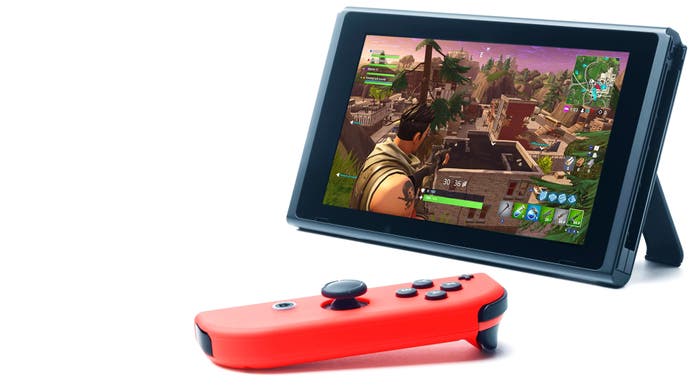Fortnite's Switch port is impressive - but frame-rate could be better
Intense combat is a little too choppy.
Fortnite finally arrived on Nintendo Switch this week, with developer Epic Games releasing it for download in the wake of Nintendo's E3 Direct. It's a title built with scalability in mind, capable of running on everything from an iPhone 6S through Xbox One X, right up to the world's most powerful gaming PCs. And going into this one, we were fascinated to see just how much performance and fidelity Epic could extract from the Switch - after all, we're looking at hybrid technology here, a machine built on a mobile chipset but with all the low-level access typically associated with a dedicated console.
The good news is that PS4 account login debacle apart, Fortnite on Switch links up perfectly with every other platform. Mechanically it's the same game - as it must be to make cross-play possible - and the Unreal Engine 4 core translates neatly to Nintendo's hardware. Inevitably, visuals and frame-rate take a hit as Switch's mobile-orientated Tegra X1 SoC has considerably less horsepower on tap than the other current-gen consoles - but that's really not the point, given it can be used as a handheld as well. The question is, to what extent do its nips and tucks matter to the competitive experience?
To answer that, we repeated the comparison process we used when we took a look at Fortnite's iOS conversion, stacking up the new port against the best of the best from the console realm - the Xbox One X build. The first difference is plain to see: a drop from the 60fps common to all the other console versions to 30fps on Switch. The standard PlayStation 4 actually has the weakest CPU of the current-gen machines - with developers able to access six-and-a-half x86 Jaguar cores running at 1.6GHz. This is a big boost over Switch, where games only have access to three ARM Cortex A57s cores running at 1GHz. Clearly, something had to give.
Obviously the experience is nowhere near as smooth, but doubling Switch's render budget by halving frame-rate lessens the strain on the CPU and allows its GPU to deliver more in both docked and mobile configurations. So if you have Nintendo's machine docked with your TV, it renders with a dynamic resolution - just like the other console builds. At top end, it hits a perfectly respectable 1600x900, with the lowest number we've seen so far resolving at 1296x729 - effectively an 80 per cent resolution scaling on both axes. Similar to the other console versions, a temporal anti-aliasing/reconstruction technique is also used that helps disguise the resolution hit, but the effect is limited, and those jaggies do show up. On the plus side the field of view (FOV) is identical between the console versions, and Switch renders a proper 1080p HUD as well.
Looking past resolution, there are plenty of chops and changes in visual settings, the most obvious being pruned back draw distances. Grass and shadows only fade in at the close-to-mid distance on Nintendo's machine, while Xbox One X renders them far, far into the horizon. It must be stressed that Epic absolutely made the right call here though. This is purely an aesthetic downgrade, and all the major geometry, trees and players render in properly on Switch - all the way into the background, ensuring a level playing field across platforms.
Of course, grass still renders in properly up close, and the core quality is untouched. Yes, the density is dropped on Switch by a notch, and you do get thicker, fuller pastures on Xbox One X - but the fact is that trees and grass animate properly for both systems, an effect that was missing even on the iOS version running on the latest iPhones. In this respect, Switch holds up well against Xbox One X, though pop-in is more noticeable.
The other big pitfall here is texture quality, though Switch's available 3GB for developers offers mostly matching textures to the Xbox One X version. The main difference really is in how they're presented, with low-grade trilinear filtering used on the Nintendo hybrid machine, creating clear cascade lines on the ground. At a distance, it turns all textures into mush, presenting as a soup-like blur unless you look directly downwards to see the texture map head-on. Only then do you realise that most assets on the ground are identical to Xbox One X, so it transpires it's really only an issue with the filtering. An unfortunate result for Switch then, but not a deal-breaker for the way the game actually plays.
And the same goes for the other real GPU-saving settings that help Switch hit that 30fps target. Shadow resolution takes a visible hit and the quality of ambient occlusion - the shade in-between objects - isn't as refined on Nintendo's portable, but still acceptable. It's clear that Epic had its work cut out for them here in bringing Fortnite to Switch, and the nips and tucks are unmistakable - lighting is missing entirely from underneath exploding grenades, with no light bounce at all on nearby objects. Added to that, god-rays - a staple Unreal Engine 4 effect - are also disabled on Nintendo's machine.
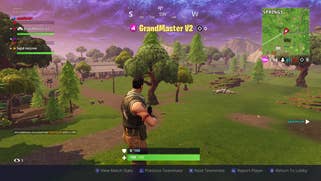
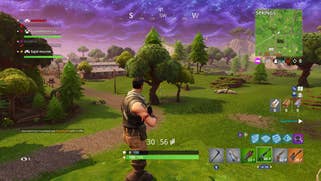

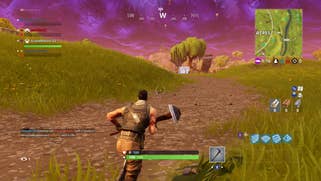
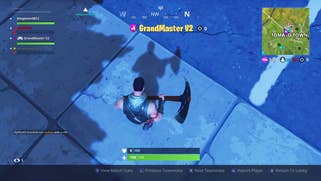


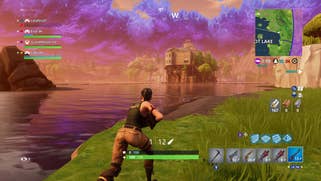


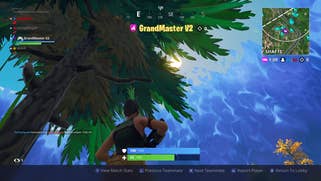
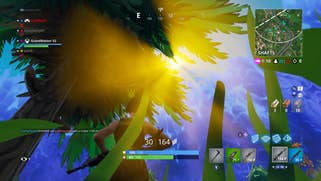
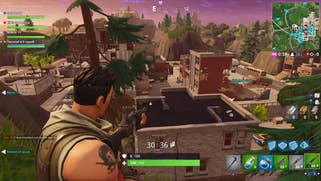
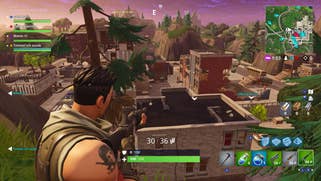
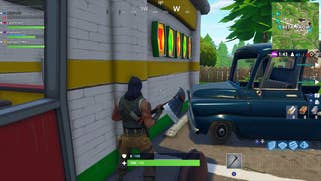

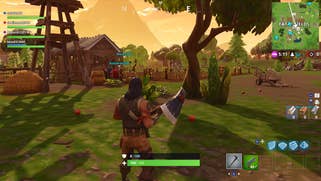
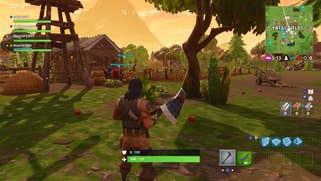
The flavour of Fortnite is retained then, but significant UE4 features like screen-space reflections are given the chop, though this is at least replaced with convincing-enough cubemap reflections. It's a downgrade for sure, but fundamentally, in common with many of the other cutbacks, it doesn't make a huge difference to Fortnite's more stylised aesthetic on Nintendo's hybrid, and while the reflections use a basic workaround, spots like Loot Lake still look passable outside of comparisons.
All of this supposes you're playing under the TV - missing the killer feature of Switch's hybrid design: portable play. The good news? Taking it out of the dock, you'll rarely notice a difference in the visual feature-set - at least, not on the smaller screen. Shadows take a further hit in quality, as does ambient occlusion, causing more stippling and noise in the corners of rooms. And again, texture filtering is closer to the player, so you can see filtering lines on the floor more obviously - plus plant draw distances are reined in to a greater degree. But, this does involve blowing up the image to catch, and it's not representative of how you'll see it in a portable state. Taken on its own merits, the game looks great on the handheld, even with these dialled back settings.
The only downgrade that really makes an impact concerns resolution. When gaming on the go, Switch maxes out at 1280x720 to match the display, but again with dynamic resolution dropping that number below 720p where it needs to. The worst case I've found is exactly 50 per cent on each axis (making it 640x360) and yes it does look rough around the edges at that point. That really is the lowest number on record though, and again, it's all in service of hitting a similar 30fps cap.
Crucially, it still hangs together well and the pay-off is there in performance - at least in the early prep phase of a battle royale. Just like the smartphone versions, this is a 30fps experience on Switch, and initially at least, it largely holds that number well too. Network hiccups and stutters are the only problem right now, and flying over the map at the start with all 100 players does flag some clear issues. It's something all versions suffer from to an extent and server-side conditions are a factor here.
The initial hunt and gather part play nicely - for the most part - at 30fps. One blemish is that frame-pacing isn't correct, and you'll spot the occasional 16ms blip spike here and there, usually after a drop. It's not so much of an issue at the start of a game, but once the firefights kick off at the map's centre, expect to see that frame-rate line get more and more erratic.
The worst case? You're looking at 20-30fps performance in docked mode when any real action kicks off, and using Switch as a portable follows the same pattern. It's clear that dynamic resolution scaling only keeps the game's frame-rate in check to a point; whole shootouts in complex spots like Tilted Towers run at around 25fps. It's expected given that all surviving players gravitate towards one point in the map, but still, it's a shame that performance drops kick in at the most crucial points in the game. In its defence, this doesn't happen every time - the location and number of players play a key role here. Equally, drops like this are generally harder to spot on Switch's smaller screen, when the system is used as a pure handheld.
Performance on Switch compared to Xbox One X - or indeed the other current-gen consoles versions - is sobering. Even Microsoft's top-end hardware can't manage a perfect lock at 60fps, and you can expect drops to around 50fps when the going gets really tough. In general though, you're getting a broadly 60fps experience in the build-up to any big shoot-out, and playing at home, there's no question that other console users have a competitive advantage over Switch players. Shooter controls benefit from that sharper response time, and it's not just the X that targets 60fps - all the Xbox and PlayStation consoles pull off the same feat quite convincingly, so for a truly level playing ground, it may be worthwhile limiting yourself to Switch-only servers.
Even so, despite halving frame-rate and cutting back on visual effects, the Switch release is still well worth checking out. Adapting to the 30fps cap takes no time at all if you're used to the other versions, and while Switch's performance drops are unfortunate, the fact is it's hard to beat as a portable take on Fortnite. As ever, it's best to see Switch as a powerhouse handheld with the bonus of docked TV play; in the midst of all the versions out there, the visuals hold up surprisingly well despite the cutbacks, and the game is still eminently playable. And as a handheld experience, there's nothing quite like it. The controls are spot-on, and it's remarkable to see Switch join a 100 person battle royale with platforms far ahead of it in power spec. It's not a simple proof of concept; this actually works, and even with the frame-rate issues, it's an enjoyable conversion of the year's biggest hit.
